|
|
|
Sort Order |
|
|
|
Items / Page
|
|
|
|
|
|
|
| Srl | Item |
| 1 |
ID:
060371
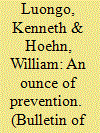

|
|
|
|
|
| Publication |
Mar-Apr 2005.
|
|
|
|
|
|
|
|
|
|
|
|
|
|
|
|
| 2 |
ID:
060786
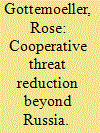

|
|
|
| 3 |
ID:
147680
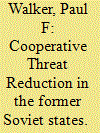

|
|
|
|
|
| Summary/Abstract |
The US Cooperative Threat Reduction (CTR) program, founded in the early 1990s to secure Soviet weapons of mass destruction (WMD)—nuclear, chemical, and biological—and promote WMD nonproliferation, has enjoyed great success. CTR has spent over $10 billion in the last twenty-five years to help eliminate thousands of nuclear warheads, dozens of nuclear submarines, 35,000 metric tons of chemical agent, and thousands of strategic missiles, bombers, and missile silos in former Soviet states. But it has also been beset with numerous funding, political, bureaucratic, technical, and planning challenges. The author reviews the history of CTR funding and legislation, discusses obstacles to implementation, and identifies five broad lessons from the program's early experiences that are applicable to future global security projects.
|
|
|
|
|
|
|
|
|
|
|
|
|
|
|
|
| 4 |
ID:
167797
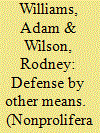

|
|
|
|
|
| Summary/Abstract |
This article discusses likely future contexts of, and options for, global threat-reduction activities to support nonproliferation goals over the next five to ten years. Threat-reduction activities span a continuum from unilateral actions that the United States might take with little cooperation and transparency at one end to cooperative actions associated with negotiated treaties and agreements at the other. This study focuses on cooperative approaches embodied in the Cooperative Threat Reduction (CTR) program, which has been the most visible program reducing the threats posed by weapons of mass destruction for over two decades. We argue that CTR’s evolution can be described in terms of the relationship between the desired US influence on outcomes, the ability to generate a common threat definition, and appetite for collaboration on threat reduction. To that end, this article provides an introduction and overview of CTR initiatives over its twenty-seven-year history and a review of relevant legislation and trends. After introducing and describing the CTR Possible Futures Framework, this article offers five possible options for—and discusses the implications of—CTR’s future evolution.
|
|
|
|
|
|
|
|
|
|
|
|
|
|
|
|
| 5 |
ID:
147684


|
|
|
|
|
| Summary/Abstract |
Libya proved to be a unique example of WMD elimination. Unlike other WMD elimination cases, which arose out of an armed conflict that resulted in an opportunity to access and destroy a WMD program, Libya began as a cooperative WMD elimination effort that took a turn after violence erupted. The first phases of elimination arose from a combination of diplomacy, economic sanctions, and fears by the Libyan government of possible military action. This phase effectively reversed Muammar Qaddafi's attempt to develop a nuclear program and prevented the Libyan government from having access to chemical weapons when the “Arab Spring” reached Libya. The ensuing civil war brought new challenges to elimination: a breakdown in security, increased risk of chemical-weapons proliferation to violent extremists, and the discovery of a previously unknown stockpile of filled chemical munitions. Following Qaddafi's death, the second phase restarted the chemical-weapons elimination and presented new challenges still. These included the need for rapid action to complete the destruction, negotiating with an interim government, and assisting destruction without US personnel on the ground in Libya.
|
|
|
|
|
|
|
|
|
|
|
|
|
|
|
|
| 6 |
ID:
089071
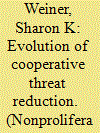

|
|
|
|
|
| Publication |
2009.
|
| Summary/Abstract |
Since its beginning in 1991, Cooperative Threat Reduction (CTR) has grown to include a host of programs aimed at securing former Soviet weapons of mass destruction, weapons-relevant materials, and expertise. Multiple U.S. and Russian agencies are involved, and some programs have expanded beyond the former Soviet Union. CTR has demonstrated considerable success, but much work remains. Moreover, it is likely that the CTR agenda will be re-evaluated and refocused owing to reviews by the Obama administration, increasingly strained relations with Russia, and the global economic crisis. Any such analysis, however, should proceed from a clear understanding of both CTR's performance to date as well as lessons learned from this experience. This article provides a start by summarizing progress toward CTR's main goals, outlining the scope of remaining tasks, and looking at persistent problems in both the United States and Russia. In particular, CTR's future progress depends upon forging a new U.S. domestic consensus on the national security benefits of CTR, encouraging Russia to become a true partner in CTR activities, and improving interagency leadership and coordination. In turn, these improvements can help resolve emerging questions about the cooperative nonproliferation agenda as it expands beyond the former Soviet Union.
|
|
|
|
|
|
|
|
|
|
|
|
|
|
|
|
| 7 |
ID:
171182


|
|
|
|
|
| Summary/Abstract |
As the United States and North Korea pursue negotiations on a “denuclearization” agreement, the two countries should consider initiating cooperative measures as a way to build confidence and encourage finalization of a complete agreement. Based on lessons from the initial engagements carried out under the Cooperative Threat Reduction (CTR) program in states of the former Soviet Union (FSU), initial cooperation should focus on safety and security, training, and infrastructure elimination. By offering to implement these initiatives now while negotiations are underway, the United States could gain additional insights into North Korean intentions. These early initiatives could be proposed without compromising the US maximum-pressure campaign on North Korea by using the current authorities of the CTR program and carefully designing specific exemptions that may be required for any agreed measures. If North Korea is truly interested in pursuing disarmament efforts, the initial cooperative projects would enable them to begin reaping potential benefits while negotiations continue with sanctions still in place. These initial proposals could also be expanded to include additional international partners such as Russia, China, South Korea, and Japan. Such programs and initiatives would support and supplement longer-term strategies to address North Korean weapons-of-mass-destruction challenges.
|
|
|
|
|
|
|
|
|
|
|
|
|
|
|
|
| 8 |
ID:
119006


|
|
|
| 9 |
ID:
082433
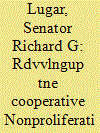

|
|
|
|
|
| Publication |
2008.
|
| Summary/Abstract |
In its sixteen years of existence, the Nunn-Lugar program has successfully dismantled nuclear, biological, and chemical weapons in the former Soviet Union. Washington's periodic disagreements with Russia should not halt this critical work. Moreover, the United States must expand the Nunn-Lugar principles to new regions of world and to new types of threats. It is particularly vital to give Nunn-Lugar the authority to work with countries under conditions where U.S. legal obstacles might otherwise bar such cooperation, and to eliminate red tape and bureaucratic burdens on the Defense Threat Reduction Agency so it can respond to unforeseen contingencies. For example, Nunn-Lugar already has destroyed a chemical weapons stockpile in Albania, and it should be given the flexibility to work in North Korea if a future agreement makes that possible. Nunn-Lugar should be expanded so the United States can work cooperatively to control stockpiles of conventional weapons, train foreign governments in the interdiction of dangerous weapons and materials, and assist in responding to attacks involving weapons of mass destruction
|
|
|
|
|
|
|
|
|
|
|
|
|
|
|
|
| 10 |
ID:
147675
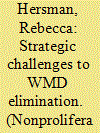

|
|
|
|
|
| Summary/Abstract |
Operations to eliminate weapons of mass destruction (WMD) are highly situation-dependent and defy easily replicable solutions and approaches. Nevertheless, by examining WMD elimination missions as they have transpired over the past several decades, we can begin to identify several consistent challenges. Learning to better prepare for these challenges—both within and across various facets of the US government as well as with our international partners—will enhance future elimination operations and their chances of success. The article concludes by asserting that military and nonmilitary approaches to these operations are not competing ideological approaches but rather reflect the complexity of the operational environment and the subsequent need for a range of legal, political, military, financial, and diplomatic tools.
|
|
|
|
|
|
|
|
|
|
|
|
|
|
|
|
| 11 |
ID:
182648
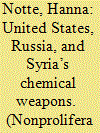

|
|
|
|
|
| Summary/Abstract |
This article analyzes the drivers of US–Russian cooperation in the disarmament of Syria’s declared chemical weapons (CW) in 2013–14, emphasizing the primary importance of credible coercion vis-à-vis the Syrian government. It identifies additional significant drivers—including the resonance of institutional memory of cooperation through the Cooperative Threat Reduction (CTR) programs; continued interest alignment for Russia through consensus on a hybrid disarmament framework; and constructive relationships among senior officials on both sides—while also showing the relevance of Russian sensitivities to status, the prospects of a new round of Syria peace talks planned at the time (“Geneva II”), and expectations of positive “spillover” from narrow cooperation on Syrian CW into other areas of US–Russian relations. The article further traces and explains the unravelling of internal consensus within the Organisation for the Prohibition of Chemical Weapons (OPCW) on the Syrian CW file between 2014 and the present day, analyzing growing frictions over the Fact-Finding Mission, the Joint Investigative Mechanism, and the Investigation and Identification Team. Disagreements within the OPCW over these issues became increasingly viewed as inextricably linked to the broader geopolitical Russia–West confrontation. Finally, the article probes the resultant implications for prospects of universalizing the 1993 Chemical Weapons Convention and making progress toward a weapons-of-mass-destruction-free zone in the Middle East.
|
|
|
|
|
|
|
|
|
|
|
|
|
|
|
|
| 12 |
ID:
147674
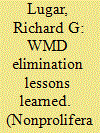

|
|
|
|
|
| Summary/Abstract |
Former Senator Richard Lugar (Republican of Indiana) provided the keynote address at the workshop held in the Washington, DC, office of the James Martin Center for Nonproliferation Studies that formed the basis of this special issue of the Nonproliferation Review. In these remarks, he discussed the importance of the Cooperative Threat Reduction programs created on 1991 legislation, co-sponsored, with Senator Sam Nunn (Democrat of Georgia). Sen. Lugar called for the maintenance and continued expansion of these programs as well as for the “creative and relentless” pursuit of new opportunities to meet evolving threats from weapons of mass destruction.
|
|
|
|
|
|
|
|
|
|
|
|
|
|
|
|
|
|
|
|
|